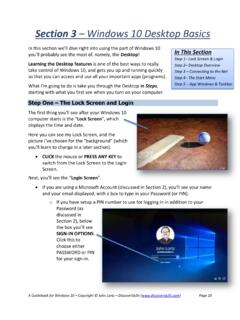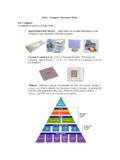Transcription of Introduction to Networking and the OSI Model
1 1O N EIntroduction toNetworking andthe OSI ModelIn this chapter, we begin our journey toward the CCNA certification by examining some Networking conceptskey to working with Cisco routers. The most importantconcept is a discussion of the OSI Model and how dataflows across a network. Once the OSI Model is under-stood, it will be easier to design, use, and, especially,troubleshoot Cisco to NetworkingIn the early days of computing, there were mainframe com-puters. These computers were large and centrally located,usually in a very cold and climate-controlled environment.
2 Although processing was performed on the mainframe,the average user did not walk up to it and start an applica-tion. Instead, he or she would sit at a terminal that was con-nected to the mainframe by some type of cabling. Thisterminal, located in a remote location, was the gateway tothe processing power of the mainframe. The terminal per-formed very little work on its own. In fact, it merely dis-played data on the monitor and processed keystrokes toIn This Chapter Local Area Networks Wide Area Networks Internetworking The Seven Layers ofthe OSI 1/3/2001 9:44 AM Page 1send back to the mainframe.
3 For this reason, these terminals were oftencalled dumb terminals. As time progressed, more and more users were connecting to the main-frame computer through the terminals. This increased the load on the main-frame, thereby slowing productivity. The mainframe computers werecontinually being enhanced and upgraded to keep up with the started producing smarter terminals to decrease the load onthe mainframe. When the personal computer (PC) became a reality in the late1980s, the paradigm began to shift.
4 PCs could connect to the mainframe inplace of the dumb terminals, but more importantly, they could process dataon their own. The PC revolution began, and the increasing importance of thehome and office computer was PCs began to work in conjunction with the mainframe, new technol-ogy was required to efficiently connect them. Local Area Networks,or LANs,became the term used to describe the way in which computers were con-nected together to share data. LANs were implemented in a business usingtechnologies such as Ethernet and Token Ring to connect computers togetherusing Network Interface Cards,or NICs.
5 LAN connectivity became a new in-dustry market, and new businesses worldwide started more and more LANs became operational, it became necessary tolink these networks together across floors, buildings, cities, and even coun-tries; hence, the Introduction of the Wide Area Network, WAN is ameans of connecting LANs together across a distance boundary. Typical WANconnectivity was accomplished through phone lines. Today, computers throughout the world are connected through WANs,LANs, and various combinations of the two.
6 Perhaps the most well-knownnetwork is the Internet. The means of connecting all these networks togetherto achieve a desired goal is called internetworking,and this is where Ciscohas positioned itself as the world OSI ModelNetworking evolved from the basic principle of moving data from one com-puter to another. The first method involved copying data to a storage mediasuch as a floppy disk and then taking that storage media to another computerand copying the data. This was charmingly referred to as sneaker-net.
7 Asmore efficient means were discovered namely, electricity on a copperwire Networking became more popular. However, there were no standardsin place. This meant that one network manufacturer implemented a differentmeans of data transfer than another. If you had an IBM network, you pur-chased only IBM network 1984, a group known as the International Organization for Standard-ization (ISO) created a Model called the Open Systems Interconnect (OSI).This Model defined guidelines for interoperability between network manufac-2 Chapter 1 Introduction to Networking and the OSI 1/3/2001 9:44 AM Page 2turers.
8 A company could now mix and match network devices and protocolsfrom various manufacturers in its own network without being locked intousing a single vendor. It also had a great side effect: Competition meant the OSI Model defined a set of standards, it is important tonote that it is merely a Model . Many other models exist in the Networking in-dustry; however, understanding a single Model gives us the capability of un-derstanding other models in the future. The OSI Model is the most widelytaught as the foundation for this Use a Layered Model ?
9 By using a layered Model , we can categorize the procedures that are neces-sary to transmit data across a network. Let s explore this in more detail. Imag-ine that we are developers and we are about to create a new protocol forcommunication across a network. First, we need to define the term protocol: A protocol is a set of guidelines or rules of communication. Some think of a protocol as a dialect of a language; this is erroneous. The British and the Americans both speak the same language: English.
10 However, certain words differ in meaningbetween the two countries. The timing of the exchange of words be-tween the two cultures can also lead to difficulties in complete under-standing. A protocol, then, is more than just the wordsof computers. It also includes the timing and the same dictionary so that at any time, bothcomputers using the same protocol have an exact, complete understanding of each other. Developing a new protocol without a Model would be a tedious andtime-consuming task.








